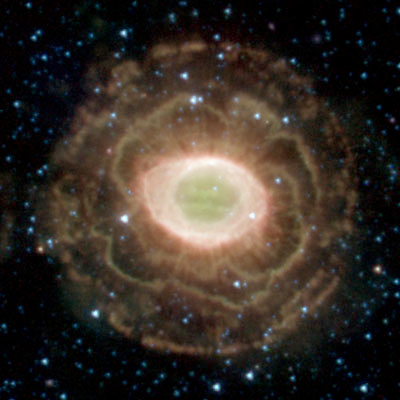 The Summer Triangle is an asterism which defines the Summer Sky. The brightest of the three stars is Vega in Lyra. The other two corner stars are Deneb, the tail of Cygnus the Swan, and Altair, found in Aquila the Eagle. Lyra contains many interesting objects for small and medium scopes. The most famous objects are the Ring Nebula and the “double-double,” epsilon Lyra. The Ring Nebula, M57, is found one third of the way between beta and gamma Lyra. In small scopes, it appears as a small hazy spot.
The Summer Triangle is an asterism which defines the Summer Sky. The brightest of the three stars is Vega in Lyra. The other two corner stars are Deneb, the tail of Cygnus the Swan, and Altair, found in Aquila the Eagle. Lyra contains many interesting objects for small and medium scopes. The most famous objects are the Ring Nebula and the “double-double,” epsilon Lyra. The Ring Nebula, M57, is found one third of the way between beta and gamma Lyra. In small scopes, it appears as a small hazy spot.
In medium scopes, its ring structure can be seen. In larger scopes, the ring structure can be seen better, as can varying widths of the ring itself. In scopes above 18”, the central star can be seen in dark skies. The nebula stands out in narrow band filters. Epsilon Lyra is composed of a pair of double stars separated by 3.5 minutes. Each star of this pair is actually a double. The pair of epsilon 1 are separated by 3 seconds, epsilon 2 by 2 seconds.
We can now turn our attention to the constellation Cygnus. The head of the Swan is the double star Alberio. It is easily seen as a beautiful double with the components seen as blue and yellow stars. In the corner of the southern wing of Cygnus is the open cluster M29. The open cluster M39 is also seen 6 degrees northwest of Deneb, but is not very spectacular.
If one moves southwest of Alberio, we can find two final Messiers. M27, The Dumbbell Nebula (bottom left, from Stu Forster), is the largest planetary nebula at mag 2. It is easily seen in binoculars and small scopes. The globular cluster M71 is found a few degrees south of M27. Don’t forget to scan all of the above constellations with wide field, low power scopes. The Milky Way is full of treasures.
-Happy Hunting, Stu
Dr. Stuart Forster was a long-time member, former president, secretary, contributing author, scope builder, astrophotographer extraordinaire, host to several of the Messier Marathons that marked the beginning of the SAS observing year, multi-lecturer at past meetings and Summer Seminars, and a true amateur astronomer’s astronomer.

